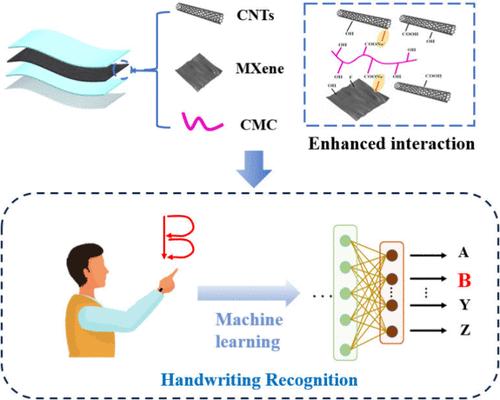利用羧甲基纤维素填充碳纳米管/MXene 制造超灵敏柔性应变传感器,用于机器学习辅助手写识别
IF 8.3
2区 材料科学
Q1 MATERIALS SCIENCE, MULTIDISCIPLINARY
引用次数: 0
摘要
将可穿戴传感器与机器学习相结合可在人机交互和医疗保健领域实现智能感知,但在柔性应变传感器中实现高灵敏度和宽工作范围以获取信号并进行准确识别仍具有挑战性。在此,我们将羧甲基纤维素(CMC)引入碳纳米管(CNTs)/MXene 混合网络,在导电材料之间形成紧密锚定,从而增强了相互作用。硅橡胶封装的 CMC 锚定碳纳米管/MXene(CCM)应变传感器具有出色的灵敏度(最大测量系数高达 71 294)、宽工作范围(200%)、超低检测限(0.05%)和卓越的耐用性(超过 10 000 次循环),优于最近报道的大多数基于导电复合膜的同类产品。此外,在聚丙烯酸粘合层的帮助下,该传感器实现了与人体皮肤的无缝结合,成功获得了稳定清晰的人体波形。在此基础上,我们提出并实现了一种新型的空气手写识别方法,通过深度神经网络辅助提取高质量应变信号的多种特征,阿拉伯数字和字母的分类准确率分别达到 98.00% 和 94.85%。我们的工作为大幅提高应变传感性能提供了有效方法,从而促进了柔性传感器的创新应用。本文章由计算机程序翻译,如有差异,请以英文原文为准。

Ultrasensitive Flexible Strain Sensor Made with Carboxymethyl-Cellulose-Anchored Carbon Nanotubes/MXene for Machine-Learning-Assisted Handwriting Recognition
The combination of wearable sensors with machine learning enables intelligent perception in human–machine interaction and healthcare, but achieving high sensitivity and a wide working range in flexible strain sensors for signal acquisition and accurate recognition remains challenging. Herein, we introduced carboxymethyl cellulose (CMC) into a carbon nanotubes (CNTs)/MXene hybrid network, forming tight anchoring among the conductive materials and, thus, bringing enhanced interaction. The silicone-rubber-encapsulated CMC-anchored CNTs/MXene (CCM) strain sensor exhibits an excellent sensitivity (maximum gauge factor up to 71 294), wide working range (200%), ultralow detection limit (0.05%), and outstanding durability (over 10 000 cycles), which is superior to most of the recently reported counterparts also based on a conductive composite film. Moreover, the sensor achieves seamless integration with human skin with the help of a poly(acrylic acid) adhesive layer, successfully obtaining stable and clear waveforms with meaningful profiles from the human body. On this basis, we proposed and realized a novel in-air handwriting recognition method via extracting multiple features of high-quality strain signals assisted by deep neural networks, achieving a high classification accuracy of 98.00 and 94.85% for Arabic numerals and letters, respectively. Our work provides an effective approach for significantly improving strain sensing performance, thereby facilitating innovative applications of flexible sensors.
求助全文
通过发布文献求助,成功后即可免费获取论文全文。
去求助
来源期刊

ACS Applied Materials & Interfaces
工程技术-材料科学:综合
CiteScore
16.00
自引率
6.30%
发文量
4978
审稿时长
1.8 months
期刊介绍:
ACS Applied Materials & Interfaces is a leading interdisciplinary journal that brings together chemists, engineers, physicists, and biologists to explore the development and utilization of newly-discovered materials and interfacial processes for specific applications. Our journal has experienced remarkable growth since its establishment in 2009, both in terms of the number of articles published and the impact of the research showcased. We are proud to foster a truly global community, with the majority of published articles originating from outside the United States, reflecting the rapid growth of applied research worldwide.
 求助内容:
求助内容: 应助结果提醒方式:
应助结果提醒方式:


